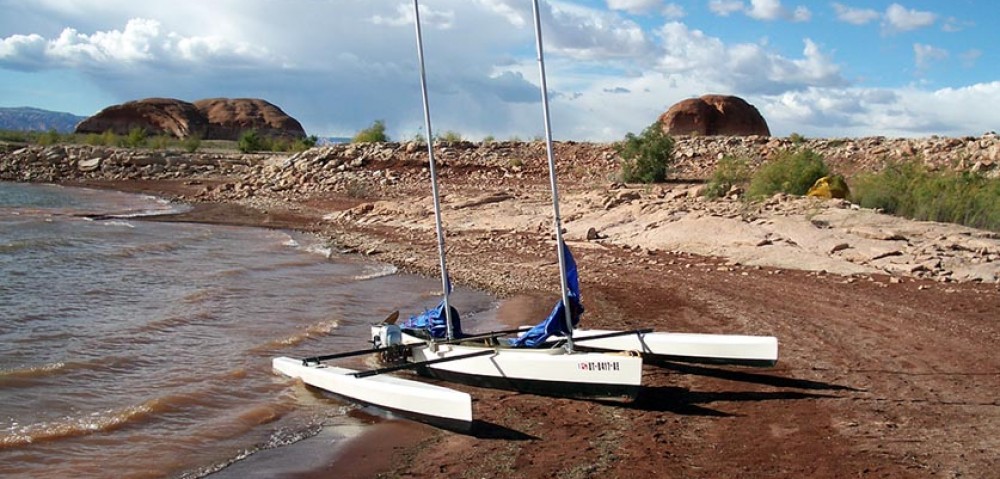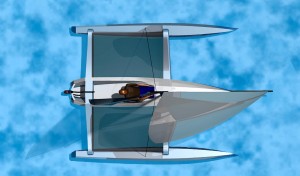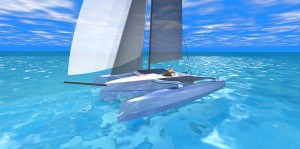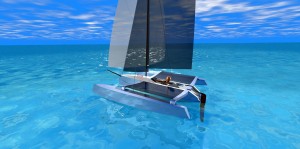Sports Car Performance on the Water

Over the past couple of years, I have taken a break from my boat design work. During that time, I’ve been able to reassess my connection to the craft. The last boat I designed was the Europa 20, which is a trimaran meant for vertical strip foam construction with sandwich style, infused epoxy/glass laminates inside and out. The Europa is a boat for very fast day sailing with a very light hull and a very big rig. A boat that is not for everyone, to be sure, as it requires a level of skill that the average guy does not typically cultivate in the course of experiencing their recreational boating interests.
In stepping away from the larger, more powerful beach type multihulls, I came around to the desire to produce a smaller, very quick and sensitive boat that would appeal to recreational sailors and not just those guys who want to blast around with their hair on fire (though I do suspect that in the right hands, this boat will do just that). The new design had to be easy to build with standard, marine plywood/epoxy/glass techniques that did not rely on exotic layups with spendy carbon cloth. (Well, maybe the carbon will sneak in there a bit on the beams for the guys who want to play with a bigger rig)
Looking long and hard at the smaller skiff-like hull designs I had done before, such as the Montage, I decided to draw the new boat in that same general size, but with a very different approach when it comes to how the boat achieves its performance potential. Where the Montage has a relatively spacious cockpit capable of taking on a couple of adults, (or a parent and a couple of smaller kids) the new, Corsica 15R trimaran would be for one adult (or accomplished kid) designed solely for a unique, one-up sailing experience within the small beach multihull genre.
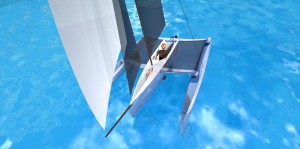 Much like a performance dinghy, the Montage has a wide, flat sailing surface conducive to the planing of the main hull. It’s more like an outrigger supported dinghy in that regard, than it is a trimaran. Certainly, the Montage fits within a grey area when it comes to defining nomenclature. The Corsica 15R, however, would be very much like other high performance trimarans with very slender, easily driven hulls that have the potential to achieve boat speeds well beyond the typical displacement design. There is no main hull planing function going on with the Corsica 15R. It is all about pure, straightforward achievable speed via well-known multihull design thinking.
Much like a performance dinghy, the Montage has a wide, flat sailing surface conducive to the planing of the main hull. It’s more like an outrigger supported dinghy in that regard, than it is a trimaran. Certainly, the Montage fits within a grey area when it comes to defining nomenclature. The Corsica 15R, however, would be very much like other high performance trimarans with very slender, easily driven hulls that have the potential to achieve boat speeds well beyond the typical displacement design. There is no main hull planing function going on with the Corsica 15R. It is all about pure, straightforward achievable speed via well-known multihull design thinking.
As a result, the boat has minimized clutter when it comes to excessive high-tech trickery. With that approach, the Corsica 15R is also going to be a boat that has much lower maintenance requirements in order to keep it in top sailing condition, as well as a much lower realized cost to get it on the water and ready to sail.
If you are into cars, as I am, then think in terms of a nicely pumped, Mazda Miata, type of boat that would be a cool, weekend canyon racer for one person. A boat that could blast around the local waters in a good breeze and give chase to other small, fast, multihulls being sailed by crews of two.
The result of this conceptualizing process is the Corsica 15R. The C15R is a boat of modest, marine plywood build techniques and is very light weight for its generous sail area. With this boat, the normal sailing position would be the skipper, semi-reclined within the main hull, driving his machine like an F1 Grand Prix car. In this configuration, the boat is designed to utilize foot pedals for steering, leaving the hands free to work the sheets. But, that’s not the only way to sail this boat. Owners who wish to sail in a more conventional multihull style, can sit-up out of the cockpit and onto the main hull cockpit gunnel, or even the trampoline surfaces all the way out to the ama, where they will steer with a tiller extension.
A construction style in multichine, 4 mm marine plywood, allows the boat to be assembled in a well-understood fashion that will go together quickly. With a subtle placement of minimal stringers and sufficient bulkheads, the C15R becomes a strong main hull shell that can absorb the loads from its sizeable rig, turning the power of the sails into forward thrust in the water.
There is no fully enclosed transom on the vaka hull. The cockpit deck is slanted gently down and aft for automatic self-draining, such as is seen in sport dinghies and larger race boats. A collection of bulkheads under the cockpit deck provide structural support and watertight compartments ensuring that the boat will not likely sink even if large sections of the bottom are torn out from an underwater hazard while smoking along in a gin clear lagoon.
The demounted boat can be assembled easily by one person. The gently gull-winged akas are built with a glassed box beam core. The inboard ends of the akas slide into tapered sockets in the main hull and are levered in place with stainless waterstays to make ready for sailing. This, tapered socket technique prevents binding while assembling the boat, while providing a solid, hassle-free and weight minimized demounting system. The leading edges of the akas are smoothly shaped foam blocks that are glassed onto the box beam to provide an aero component, as well as creating reduced drag from waves and spray. The akas are hard fastened to the amas as a complete assembly that is easily removable from the vaka hull. The trampolines stay mounted to the akas and amas for transport and only have to be hooked and tensioned to the main hull during assembly.
The mast is a stick from a Hobie 16. I specify the addition of a set of spreaders from the Hobie 18 mast to stiffen up the H16 mast to handle the additional righting moment generated by the Corsica design. Naturally, I’d prefer to see fresh sails in something like fully battened, Pentex laminate, but builders on a tight budget could also work with a loft service to tweak a reasonably fresh Hobie 16 main and jib and do just fine. The addition of reefing points on the main are strongly suggested, as well as the use of furlers for the jib and spinnaker/screacher. For those who desire fresh sails for this boat, I would recommend the folks at Whirlwind sails in San Diego, California. http://www.whirlwindsails.com/
A removable carbon prodder sets the tone at the front end of the boat. The stick originates as a carbon windsurf mast, so it is easily found on the used market and equally replaceable, should it get poked into an unyielding environment. For trailering, the sprit unpins, slides out of its socket and is stowed in the cockpit for transport and storage.
Corsica 15R Specifcations
LOA 14’ 11” (4.54 m)
BOA 13’ (3.96 m)
Displacement 650 lbs. (294.8 kg.)
Sail Area (upwind) 218 sq. ft. (16.17 sq. m)
Spin 142 sq. ft. (13.19 sq. m)
Mast Length 26’ (7.62 m)
Draft (board up) 1’ (.3 m)
Draft (board down) 42” (1.07 m)
The mast is raised by the traditional beach cat method of physically lifting the mast with the base pinned to the mast step, or by utilizing the long daggerboard in its trunk as a form of a gin pole. A forward hoisting line is led over a pair of sheaves at the top of the daggerboard and down to the hand cranked winch on the trailer. Mechanical leverage quickly raises the mast so that the forestay can be fastened to the bow, stepping the mast securely. You can see a few photos of the process at Brent’s L7 trimaran site:
http://home.comcast.net/~ritakend/site/?/page/Mast_Raising/&PHPSESSID=864f3404e3f46ed29dd99b863018fc1d This is a very simple way to raise a mast should you need to avoid the trad lifting exercise for one reason or another.
I chose to not go with tricked-out, curved lifting foils in the amas due to construction complexity and added cost for the builder. Foils of this type are hard to build correctly by hand, as are the needed curved trunks in which they slide. Instead, the boat is equipped with a daggerboard that is inserted through the deck of the main hull in front of the mast which angles aft to exit the hull below the waterline. A daggerboard and trunk of this type are much simpler forms to build and orient in the hull. It is also just one main foil, where lifting foils need to be made in pairs, one for each ama. Lifting foils also need complex control mechanisms to retract and deploy the foils and they have to work from the cockpit remotely with the foils mounted way out in the amas. The needed controls are an interesting problem when the boat is 13’ in width and the driver is semi-reclined in the main hull.
Note: I’m not against an owner who might want to experiment with foiling for this boat, even if it is just foil assist and not full flying. It would require a lifting t-foil style rudder and twin Bruce style foils in the amas, or, if a person is really accomplished as a composites builder, they could make a pair of matching c-foils for the ama. The owner just needs to know what level of additional work is involved and at what skill level they need to perform in order to get the desired result.
If you are on a budget, the rudder and headstock from a Hobie 16 will work just fine for the Corsica with some mods to the tiller. The more deluxe, Rudder 25 system from Dotan will also work well, should you have the coin. http://www.dotan.com/ If you plan on pushing the boat hard, then a longer blade will be required, or you can get yourself invested in the process of putting a rudder on each ama and have stunning control at your finger tips. On the down side, that change will cost you a bit out of your pocket and at the launch ramp in setup time… though I can see a nifty rig with light alu tubing and the use of snap buttons as a cool solution.
The Corsica 15R will be a light boat built from familiar materials. It should be a fairly simple building experience for the owner and will fit comfortably into any typical garage space, making it easy to find a building location. It will quickly assemble for sailing and be hassle free with minimal maintenance required to keep it in top form. It can be towed behind any compact car on a typical beach cat trailer and when demounted for travel, is road legal anywhere in the world. On the water, this boat should be quite quick and behave with predictable, pin-point sailing manners. With the skipper slung comfortably in his reclined cockpit seat, he will be decently protected from the effects of the weather and sea state while tearing around his local waters.
Chris Ostlind
Lunada Design
